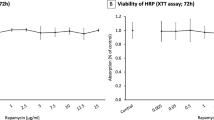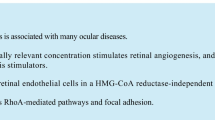Abstract
Background
Quercetin is a natural substance found abundantly in grapes, red wine and other food products. In this study, we examined the effect of quercetin on choroidal and retinal angiogenesis in vitro using rhesus choroids-retina endothelial cell line (RF/6A).
Methods
RF/6A cells were cultured in Dulbecco’s Modified Eagle’s Medium (DMEM) containing 10% fetal bovine serum. Then cells were treated with different concentrations (from 0 to 100 μM) of quercetin. The cell proliferation was assessed using choromogenic methylthiazol tetrazolium bromide (MTT) dye after 24, 48 and 72 hours. Cell migration after 24-hour incubation with quercetin was investigated by wound assay. Following exposure to the various concentrations of quercetin for 24 hours, tube formation on matrigel by endothelial cells was also analyzed. Apoptosis was measured by flow cytometry using annexin V-FITC and propidium iodide staining.
Results
Quercetin inhibits endothelial cell proliferation in a dose-dependent fashion; 10.1%, 42.6% and 65.2% inhibition on treating with 10, 50 and 100 μM Quercetin respectively. The migration and tube formation of RA/6A cells were also significantly inhibited by quercetin in a dose-dependent manner. Flow cytometric analysis showed that the percentages of apoptotic cells were slightly increased only in 100 μM quercetin-treated cells.
Conclusions
Our results show that quercetin inhibits choroidal and retinal angiogenesis in vitro. Further studies are ongoing to evaluate this drug as a potential candidate for the treatment of choroidal or retinal neovascularization.





Similar content being viewed by others
References
Risau W (1997) Mechanisms of angiogenesis. Nature 386:671–674
Klagsbrun M., Moses MA (1999) Molecular angiogenesis. Chem Biol 6:217–224
Ferris FL, Fine SL, Hyman L (1984) Age-related macular degeneration and blindness due to neovascular maculopathy. Arch Ophthalmol 102:1640–1642
Green WR (1999) Histopathology of age-related macular degeneration. Mol Vis 5:27–31
Engerman RL (1989) Pathogenesis of diabetic retinopathy. Diabetes 38:1203–1206
Aiello LP (2003) Perspectives on diabetic retinopathy. Am J Ophthalmol 136:122–135
Fielder AR, Reynolds JD (2001) Retinopathy of prematurity: clinical aspects. Semin Neonatol 6:461–475
Lamson D, Brignall M (2000) Antioxidants and cancer III: quercetin. Altern Med Rev 5:196–208
Sellappan S, Akoh C (2002) Flavonoids and antioxidant capacity of Georgia grown Vidalia onions. J Agric Food Chem 50:5338–5342
Formica JV, Regelson W (1995) Review of the biology of Quercetin and related bioflavonoids. Food Chem Toxicol 33:1061–1080
Lee K, Kim Y, Kim D et al (2003) Major phenolics in apple and their contribution to the total antioxidant capacity. J Agric Food Chem 51:6516–6520
Wilson WJ, Poellinger L (2002) The dietary flavonoid quercetin modulates HIF-1a activity in endothelial cells. Biochem Biophys Res Commun 293:446–450
Lou DA, Hu FN (1987) Co-distribution of Von Willebrand factor and fibronectin in cultured rhesus endothelial cells. Histochem J 19:431–438
Lou DA, HU FN (1987) Specific antigen and organelle expression of a long-term rhesus endothelial cell line. In Vitro Cell Dev Biol 23:75–85
Atsushi K, Norihito S, Maki O (2004) Apelin is a novel angiogenic factor in retinal endothelial cells. Biochem Biophys Res Commun 325:395–400
Shen SR, Yu HN, Chen P, Yin JJ, Xiong YJ (2007) Fatty acids in tea shoots and their effects on the growth of retinal RF/6A endothelial cell lines. Mol Nutr Food Res 51:221–228
Klein R, Klein BE, Moss SF et al (1984) The Wisconsin epidemiologic study of diabetic retinopathy. IV Diabetic macular edema. Ophthalmology 91:1464–1474
Campochiaro PA (2000) Retinal and choroidal neovascularization. J Cell Physiol 184:301–310
Boer V, Dihal A, Woude H et al (2005) Tissue distribution of quercetin in rats and pigs. J Nutr 135:1718–1725
Corvazier E, Maclouf J (1985) Interference of some flavonoids and non-steroidal anti-inflamatory drugs with oxidative metabolism of arachidonic acid by human platelets and neutrophilis. Biochem Biophys Acta 835:315–321
Havesteen B (1983) Flavonoids, a class of natural products of high pharmacological potency. Biochem Pharmacol 32:1141–1148
Castillo MH, Perkins E, Campbell JH et al (1989) The effects of the bioflavonoid quercetin on squamous cell carcinoma of head and neck origin. Am J Surg 158:351–355
Rodgers EH, Grant MH (1998) The effect of the flavonoids, quercetin, myricetin and epicatechin on the growth and enzyme activities of MCF 7 human breast cancer cells. Chem Biol Interact 116:213–228
Fotsis T, Pepper MS, Aktas E et al (1997) Flavonoids, dietary-derived inhibitors of cell proliferation and in vitro angiogenesis. Cancer Res 57:2916–2921
Metodiewa D, Jaiswal AK, Cenas N et al (1999) Quercetin may act as a cytotoxic prooxidant after its metabolic activation to semiquinone and quinoidal product. Free Rad Biol Med 26:107–116
Agullo G, Gamet-Payrastre L, Manenti S et al (1997) Relationship between flavonoid structure and inhibition of phosphatidylinositol 3-kinase: a comparison with tyrosine kinase and protein kinase C inhibition. Biochem Pharmacol 53:1649–1657
Fabbro D, Buchdunger E, Wood J et al (1999) Inhibitors of protein kinases: CGP41251, a protein kinase inhibitor with potential as an anticancer agent. Pharmacol Ther 82:293–301
Yoshiji H, Kuriyama S, Ways DK et al (1999) Protein kinase C lies on the signaling pathway for vascular endothelial growth factor-mediated tumor development and angiogenesis. Cancer Res 59:4413–4418
Alexander V, Ljubimov S, Caballero AM (2004) Involvement of protein kinase CK2 in angiogenesis and retinal neovascularization. Invest Ophthalmol Vis Sc 45:4583–4591
Jackson SJ, Venema RC (2006) Quercetin inhibits eNOS, microtubule polymerization, and mitotic progression in bovine aortic endothelial cells. J Nutr 136:1178–1184
Kobayashi T, Nakata T, Kuzumaki T (2002) Effect of flavonoids on cell cycle progression in prostate cancer cells. Cancer Lett 176:17–23
Kuo SM, Morehouse HF, Lin CP (1997) Effect of antiproliferative flavonoids on ascornic acid accumulation in human colon adenocarcinoma cells. Cancer Lett 116:131–137
Lamson DW, Brignall MS (2000) Antioxidants and cancer, Part 3: quercetin. Altern Med Rev 5:196–208
Tan WF, Lin LP, Li MH et al (2003) Quercetin, a dietary—derived flavonoid, possesses antiangiogenic potential. Eur J Pharmacol 459:255–262
Csokay B, Prajda N, Weber G et al (1997) Molecular mechanisms in the antiproliferative action of quercetin. Life Sci 60:2157–2163
Richter M, Ebermann R, Marian B (1999) Quercetin—induced apoptosis in colorectal tumor cells: possible role of EGF receptor signaling. Nutr Cancer 34:88–99
Acknowledgements
This research was supported by Beijing Technology Star Plan.
Author information
Authors and Affiliations
Corresponding author
Rights and permissions
About this article
Cite this article
Chen, Y., Li, Xx., Xing, Nz. et al. Quercetin inhibits choroidal and retinal angiogenesis in vitro. Graefes Arch Clin Exp Ophthalmol 246, 373–378 (2008). https://doi.org/10.1007/s00417-007-0728-9
Received:
Revised:
Accepted:
Published:
Issue Date:
DOI: https://doi.org/10.1007/s00417-007-0728-9




